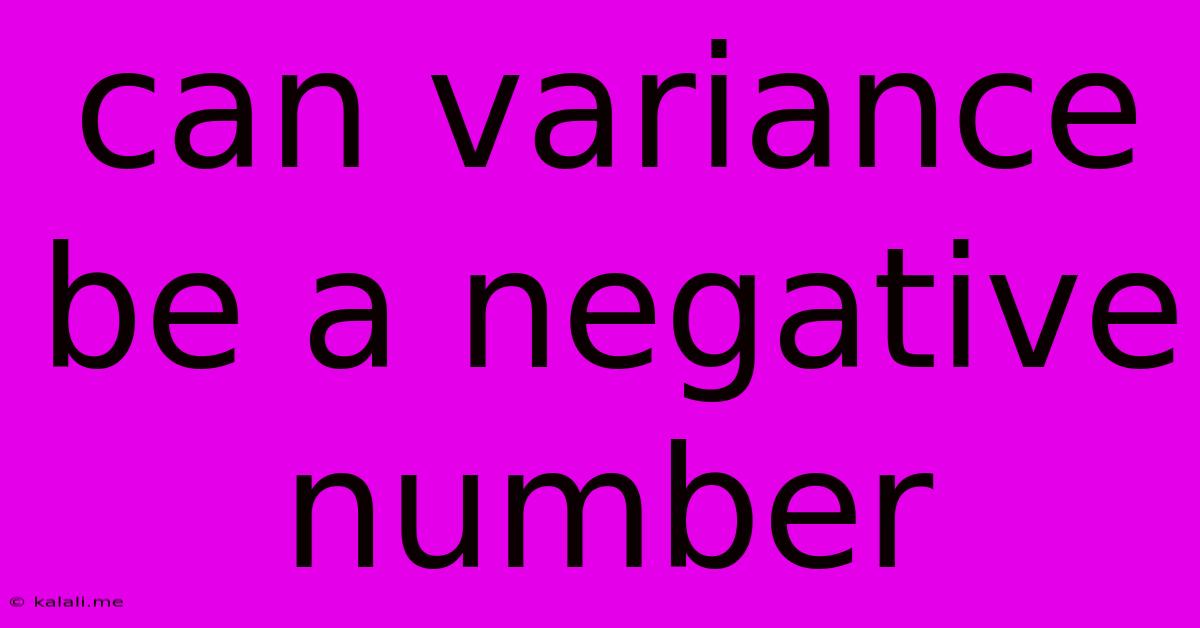Can Variance Be A Negative Number
Kalali
May 31, 2025 · 3 min read

Table of Contents
Can Variance Be a Negative Number? A Deep Dive into Statistical Dispersion
Variance, a crucial concept in statistics, measures the spread or dispersion of a dataset. It quantifies how far individual data points are from the mean (average). A common question arises: can variance be a negative number? The short answer is no. This article will explore why, delving into the mathematical definition of variance and the reasons behind its non-negativity. Understanding this fundamental property is critical for interpreting statistical results and applying them correctly.
The calculation of variance involves squaring the deviations from the mean. This squaring operation is the key to understanding why a negative variance is impossible. Let's break down the formula:
Variance = Σ[(xᵢ - μ)²] / (n - 1) or Variance = Σ[(xᵢ - μ)²] / n
Where:
- xᵢ: Represents each individual data point in the dataset.
- μ: Represents the population mean (average) of the dataset.
- n: Represents the total number of data points in the dataset.
- Σ: Represents the summation (adding up all the values).
- (n-1) is used for sample variance, while n is used for population variance. The difference is subtle but important in statistical inference.
Notice the crucial element: (xᵢ - μ)². This term represents the squared difference between each data point and the mean. Squaring any real number, whether positive or negative, always results in a non-negative value (a positive number or zero). Therefore, each individual term within the summation is always greater than or equal to zero.
Consequently, the sum of these non-negative terms (Σ[(xᵢ - μ)²]) must also be non-negative. Dividing a non-negative number by a positive number (n or n-1) will still result in a non-negative value. This mathematically proves that variance can never be negative.
Understanding the Implications of Non-Negative Variance
The non-negative nature of variance has important implications:
- Interpretation: A variance of zero signifies that all data points are identical, indicating no dispersion. A higher variance indicates greater dispersion, meaning the data points are more spread out from the mean.
- Standard Deviation: The standard deviation, the square root of the variance, also maintains non-negativity due to the square root of a non-negative number always being non-negative. This provides a readily interpretable measure of spread in the original units of measurement.
- Statistical Tests: Many statistical tests and analyses rely on variance or its square root, the standard deviation. The non-negativity of these measures is fundamental to the validity and interpretation of these analyses.
Common Mistakes and Misconceptions
While a negative variance is mathematically impossible, errors in data entry or calculation can sometimes lead to seemingly negative results. Always double-check your data and calculations to identify potential errors if you encounter such a situation. Understanding the formula and its implications helps avoid misinterpretations.
In conclusion, the inherent mathematical structure of the variance calculation guarantees its non-negativity. Understanding this property is essential for correctly interpreting statistical results and applying statistical methods effectively. A negative variance should always be treated as an indicator of an error in the data or calculations, not a valid statistical result.
Latest Posts
Latest Posts
-
Furnace Shuts Off After A Few Minutes
Jun 02, 2025
-
Cannot Turn On Calls On Other Devices
Jun 02, 2025
-
Why Did My Outlet Stop Working
Jun 02, 2025
-
Explain Why The Density Of Ice Is Less Than Water
Jun 02, 2025
-
White Vinegar Vs Rice Wine Vinegar
Jun 02, 2025
Related Post
Thank you for visiting our website which covers about Can Variance Be A Negative Number . We hope the information provided has been useful to you. Feel free to contact us if you have any questions or need further assistance. See you next time and don't miss to bookmark.